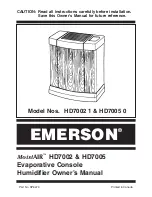
1-877-420-1330
Quest 215 Dual
Installation, Operation and Maintenance Instructions
11
www.QuestHydro.com
8.2 Technical Description
The Quest 215 Dual uses a refrigeration system similar to an air conditioner's to remove heat and moisture from incoming air, and
add heat to the air that is discharged (See Figure 15).
Hot, high-pressure refrigerant gas is routed from the compressor to the condenser coil (See Figure 3). The refrigerant is cooled
and condensed by giving up its heat to the air that is about to be discharged from the unit. The refrigerant liquid then passes
through a filter/drier and capillary tubing which causes the refrigerant pressure and temperature to drop. It next enters the
evaporator coil where it absorbs heat from the incoming air and evaporates. The evaporator operates in a flooded condition, which
means that all the evaporator tubes contain liquid refrigerant during normal operation. A flooded evaporator should maintain
nearly constant pressure and temperature across the entire coil, from inlet to outlet.
The mixture of gas and liquid refrigerant enter the accumulator after leaving the evaporator coil. The accumulator prevents any
liquid refrigerant from reaching the compressor. The compressor evacuates the cool refrigerant gas from the accumulator and
compresses it to a high pressure and temperature to repeat the process.
8.3 Troubleshooting
Neither fan nor compressor running. Dehumidification is being called for. No fan call.
1. Unit unplugged or no power to outlet.
2. Humidity control set too high.
3. Loose connection in internal or control wiring.
4. Defective Compressor relay.
5. Defective control transformer.
Compressor is not running. Dehumidification is being called for. No fan call.
1. Defective compressor run capacitor (Sec. 7.6).
2. Loose connection in compressor circuit.
3. Defective compressor overload (Sec. 7.6A).
4. Defective compressor (Sec. 7.6).
5. Defrost thermostat open.
Figure 15: Refrigeration System of Quest 215 Dual






































